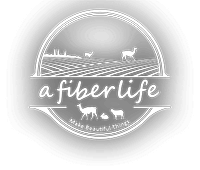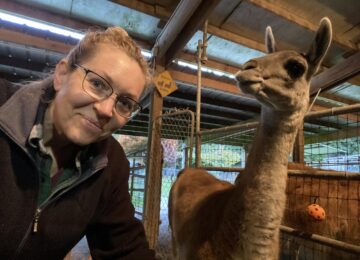“They’re all lined up. Yeah.” I responded.
“I needed something that was super fine, because the fiber is super fine.
And they’re hard to find. But I saw somebody talking about Andrew Forsyth and the fact that he made these beautiful wool combs. So of course, I found that Andrew Forsyth is in Canada, and went to his website, which is very friendly and very, pretty much old-school. I also learned that he wasn’t making the combs anymore. But if you wanted, and if he felt like making some, he might pull names off of the waiting list and say that he just decided to make a few. And so I emailed his wife, Susan, (I think that’s her name) and said, hey, you know, can you put me on the list? And she emailed me back and said, Sure, and so I think it was a year later, I had forgotten that I had done that. And sure enough, I got an email and it said, “we will have a few sets available. Are you interested?” And I said “absolutely!” And sure enough, this beautiful box came in the mail. And it’s something. These tools are something that I use pretty regularly. And I covet the artistry of this box.”
Intrigued, Greg said, “I do want to see the tools. The box, actually itself is very pretty and well thought out.”
“It really is,” I responded. “I mean, it’s a leather handle, a real leather handle that’s been dyed this beautiful red. And it says on top “Forsyth Wool Combs, four pitch super fine.” And I got to pick the wood of not just the box, but also of the combs.”
“There’s a door that looks like a little slide door that opens?” Greg asked.
“Yes, it opens up. And then here’s the comb that comes out of this little hole,” I explained.
“It’s so beautifully designed. It really is,” Greg marveled.
I went on, “And this is walnut and it’s hand turned. Look at that. Does that look like a chair leg? Like an old fashion gorgeous chair leg?”
“Yeah, it really does,” Greg said.
I persisted, “And then how does it feel?”
“The dowel,” Greg said picking it up. “It looks clunky, big and meaty. But it feels so light. And so easy to handle.”
“It’s weighted beautifully,” I explained. “Okay, so then that’s just one part of it. Okay, so ready? So now you pull out this drawer.
“Oh my god,” Greg exclaimed as I showed him more of the tool kit.
“So then there’s this,” I demonstrated. “It’s like a little dollhouse for the wool combs. Okay, so now, this is the stationery, comb. And again, it’s walnut. And you can see how gorgeously finished the curve is. And by the way, I didn’t mention the the tines.”
“The tines are very scary. And they still have some fiber on them,” Greg remarked.
“They do because I use them quite a lot,” I bragged. “Four rows of tines. You set it on the table. And then now you reach back in the drawer, and you get the little clamps that are also wooden. None of this like C-clamp stuff, right? It’s gorgeously finished. Okay, and then they go in like this,” I said, placing the combs inside the special box compartment.
“You know,” Greg said, admiring the clamps. “That’s sort of ingenious, actually. It has a way of holding it firmly to the table or whatever.”
“Well, it’s completely adjustable,” I said. “So one clamp goes in one side of the stationary comb. So it’s on the edge of the table. And then here’s the other clamp. And then you tighten. And you tighten nicely,” I demonstrated for Greg. So then you’re done with the box until you want to put it away. And what you do is you take some Merino. Just a little bit, but the combs do a great job of getting it out. And so then you take your locks and the tip end. It sticks out and the cut end goes on the comb. So you put it down like that. And then more. Here’s another, sliding it down and you’re just loading your comb up with the Merino. Lining all was beautiful fibers up. It’s just so beautiful. Like you’re ready to spin it and you’re gonna get this,” I pulled the woven fiber out. “Very, very lovely, smooth.”
“And it’s springy” Greg noticed.
“It’s still springing. Yeah,” I said. “So that’s my Andrew Forsyth wool comb set. Can you see why I love it so much.”
“I can,” Greg responded. “I can also see why it’s sort of hypnotic to just sit and use it for a couple hours.”
It’s true. I love using my wool combs. They’re beautiful and useful. They are simple and durable.
Historically, tools had to be handmade. There was no Home Depot in 300 AD where you could go to buy tools. And there weren’t factories where tools were made by machines. So, by the very nature of making tools from our own hands, they became art. We embellished the tools. The maker left their mark, their fingerprints, their individual beauty on these tools. Which in turn got passed to the person who would use those tools to make their art with. So there’s a special connection with the tool makers—makers from time immemorial. Tools were so important to early people that they were actually buried with them. Spindle whorls rest with the dead in the pre-Columbian era. That’s how special they were.
I like to think of my making with these handmade tools as a prayer, or an honoring of all those makers who came before me. And it turns out I’m not alone. This Fall, I was hanging out at the Oregon Flock and Fiber Festival. It’s like summer camp for fiber artists. I bumped into a friend of mine at the Jenkins Spindle booth. She had a pile of spindles she was about to purchase in her hands, and was checking a list like she was at the grocery store. Linda always has a spindle in her hands, so I thought she was the perfect person to talk with about loving tools; particularly Ed Jenkins’ spindles.
“Okay. So what are you shopping for?” I inquired to Linda.
“Well, I’m shopping for some friends who couldn’t come that want Jenkins spindles,” Linda replied.
“Why would they covet Jenkins spindles?” I asked.
“Because they’re very, very nice spinners and I really enjoy them. And I usually have a Jenkins with me at the guild meetings and anyplace I go and I sit and spin,” Linda explained. “You know, some people sit and knit. I sit and spin. And they’re very portable, and they’re very light and they’re beautiful. And so they’re just a pleasure to spin with.”
“What kind of wood did you buy?” I asked, digging deeper.
“Well, let’s see,” Linda said, shuffling around her full arms. “It looks like right now. I’ve got the fruit woods. So apple pear. Let’s see… and I’ve got a big leaf maple, which is really, really pretty.”
How many Jenkins spindles does Linda personally own?
“Do I have to know a number?” She laughed. “It’s a lot. I have at least two of every style. Is this a confession? I was gonna say, ‘do I have to confess to this?’ I love it.”
A funny thing happened after that, I turned around to look at the display and began to admire one of the spindles, only to turn back to see Linda checking her phone. I noticed that she now had another list up on her phone. I had to ask her about it.
“Well, what are you showing me now?” I prodded.
“I’m showing you the list of Jenkins spindles that I own. And it’s kind of long, it doesn’t all fit on one screen,” Linda said.
“Okay, so it’s on your phone on your iPad, iPhone and it you have to scroll up and down because it’s such a long list. Yes. And you have it with you because?” I asked.
“So that I don’t get too much of the same thing. So when I come to find more, I don’t have a repeat,” Linda explained. Well, or that I know that there’s a certain weight that I really like, and this way then I don’t get confused. And I remember you only
“You’ve also recorded the weights, right? Can you read a little bit?” I encouraged her.
“So I have two that he doesn’t make any more than delights. And then the Finch, which is a little spindle which I can spin cotton with. I have a birds-eye maple, a pink ivory wood, a Manzanita, mahogany and a lilac,” Linda listed.
“All in that one kind?” I asked.
“All in that one kind,” she said.
So we were laughing, but it is serious business. There is a passion many of us share for handcrafted tools. I decided to ask Ed Jenkins himself what it is that he thought made his spindles so popular. I showed Ed Linda’s list of spindles.
“That’s always crazy to me,” Ed laughed. “How many are here? Thirty? Forty? I don’t know. Man, people are interesting to say the least with these things.”
I asked Ed to say a few words about his creation process and the tools he builds.
“I make Turkish drop spindles,” he began. “I have been doing it for 17 years, or something. I have used about 180 varieties of wood. I prefer to use domestic woods now as much as possible. I make about eight or nine different spindles, and I love doing my work.
“What do you love so much about it?” I asked.
“I love wood. I just love wood,” Ed plainly said. “So it’s the only thing I’ve ever wanted to do, ever. And I’m doing it. And I think, like I tell some people, it’s peaceful. And I like that.”
“Do you think that people who buy your spindles can feel your love?” I curiously inquired.
“Oh, I think so,” Ed quickly replied. “Because they’ll have 30 of them. Because they just want to touch them. You want to look at them. It’s an incredible material. It’s better than the fuzz that they use to make threads. Just to make these is a dream come true for me.”
“That’s so special,” I told Ed. “I was here yesterday a couple of times, and the line to talk to you and to purchase one of your spindles was three deep all around your booth. What’s that about?”
“Well it’s not my good looks!” Ed joked.
“It’s your love of wood.” I said.
“Yes, I think. I’ve asked myself that question. And I don’t have an answer for it, to be honest with you.” Ed said. “I enjoy meeting the people. I enjoy seeing what they make. I enjoy watching them get excited. Because I get excited like that when I make them. Or even think about making them.”
There’s another kind of connection that happens when you use a special tool to do your art.
It’s the love and connection you feel with the former owner. Or with all of the history you bring because you’ve owned and used a cherished tool for a lifetime.
When my bid won me a Niddy Noddy award at the guild auction, I was unaware of its history. It was happy to have my tool–wooden, adjustable, a good handy tool to make skeins of yarn in various sizes. Afterwards, a few guild members came up to me and said with sincerity, “That tool belonged to Ann. She would be so happy that you have it now.” Ann was a beloved guild member who passed, and her tools dispersed into the pool of other weavers and spinners. Kathy was the recipient of Anne’s pocket wheel. Someone at the holiday spin gathering whispered to her, “Is that Ann’s wheel?” Kathy nodded with a sad smile; like she missed Ann, but treasured the fact that she got to keep Ann with her while she spun on the wheel.
I have special tools like this, too. I brought some out to show Greg.
“Okay, this. This is so cool,” I began. So, when my grandmother died, I inherited all of her knitting tools. And, and I love them. Like my bakelite knitting needles and Amber. I mean, it’s really interesting stuff that I don’t necessarily use just because they’re brittle. They’re not usable. But this I found and I don’t really know the whole history, but it’s so cool—this is a crochet hook. Look at that. Feel it.”
“It’s made out of steel, is what it feels like,” Greg said. “I mean, but some old-fashioned typed. Yeah, casted steel and someone has taken a file or some sort of tool to the end of it to make the hook.”
“Yeah, you can see how it’s sort of hand-filed,” I showed. “So the back of this little box that’s in my grandmother’s handwriting says “handmade crochet hook from a pitchfork.” Oh, and then it’s by Morgan, in Pomona, California. And that was Morgan, who came from Wales, emigrated to California, and had his little knot from his orchard. And they made a crochet hook out of Pitchfork.
“That’s from your ancestor and her ancestor,” Greg said in astonishment.
“Isn’t that special?” I asked.
“It really is,” he replied. “Yeah. Look at that. It does look like a pitchfork tine now that you’ve mentioned it, that someone cut off and then spent a lot of time shaping the point into a crochet hook.”
“And there’s a whole story of that,” I said.” Like, was it for his wife? You know, my great grandmother, his daughter, his daughter, Ruth, my mother, my grandmother? What was that about? It’s such a cool connection, to hold it and think about how he made it, and then my grandmother kept it and she probably used it.”
I asked Greg if he had any special tools. And sure enough, he has a bar. He took me to the barn to show it to me; the tool that he treasures.
“It should be over here,” Greg said as we walked through our barn. “Yep. It’s right here. See? It’s right with the other tools
It was jammed in pretty good with other items.
“God, it’s much bigger than I thought it was,” I said.
“It’s about 6 feet tall,” Greg said proudly.
“I can’t even lift it,” I said struggling with the large metal bar. “Oh my god, I never lifted it up. How much does that weigh?”
“It weighs about 40 pounds, 45 pounds, maybe a little more,” Greg said with a smile. “I mean, it’s definitely handy when you use it. Its force equals mass times acceleration, and the mass really helps you.”
“It does look a bit hand forged. Doesn’t it?” I asked. “Have you ever noticed that? It looks like somebody did that.”
“It really does,” Greg said. “It’s also very beat up. But it does look hand-forged.”
“There’s little bubbles from the iron where it kind of gives it a good grip,” I noticed.
“Well, it is cast iron. I mean, it’s not steel. This is just old iron. This is my diggin’ iron that I’ve had forever. And of course, I had to bring it here when we moved here,” Greg said.
“That tool and you go a long way back?” I asked. “How long?”
“I can’t even tell you where I got it,” Greg said.
“So other than its extreme effectiveness, and its extreme strength, and you know, everlasting quality, what does it do for you when you use it?” I asked.
“What does it do for me? Yeah, it creates fatigue in my back pretty quickly,” Greg laughed.
“Is it your longest owned tool?” I questioned.
“Yes, I believe it is” he said. “Of all the tools I have, I think that’s been with me the longest. It’s lasted through all kinds of different shovels and rakes, and you name it, all that stuff. And I think it’s persistent. It has enjoyed a long labor intensive life. And you know, it is indestructible. You can see I’m far more destructible than it is. Now I’ll put it back in the rack, where all the tools hang out.”
“That’s awesome,” I said, staring at the old iron bar.
So whether it is an artisan crafted tool, a family heirloom, or your trustiest diggin’ iron, don’t take your tools for granted. They are not just tools. Celebrate their stories. Treasure their makers. And join hands with the community of makers whose handprints are forever stamped onto the tools you hold. Then, you will not feel alone. The term “handmade” or “handcrafted” can take on a new meaning. And each time you walk into your barn, or your studio, or even your kitchen and pick up those tools, you will feel love and connection.
Thanks for listening. If you’d like to hear more stories about our farm life and what we learn when we live close to nature and use our hands to make things from what we raise, be sure to follow us on your favorite podcast listening app–or, if you want to be notified every time we post a new episode, you can sign up for those notifications here on our website, afiberlife.com.









